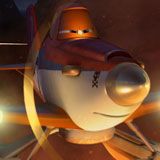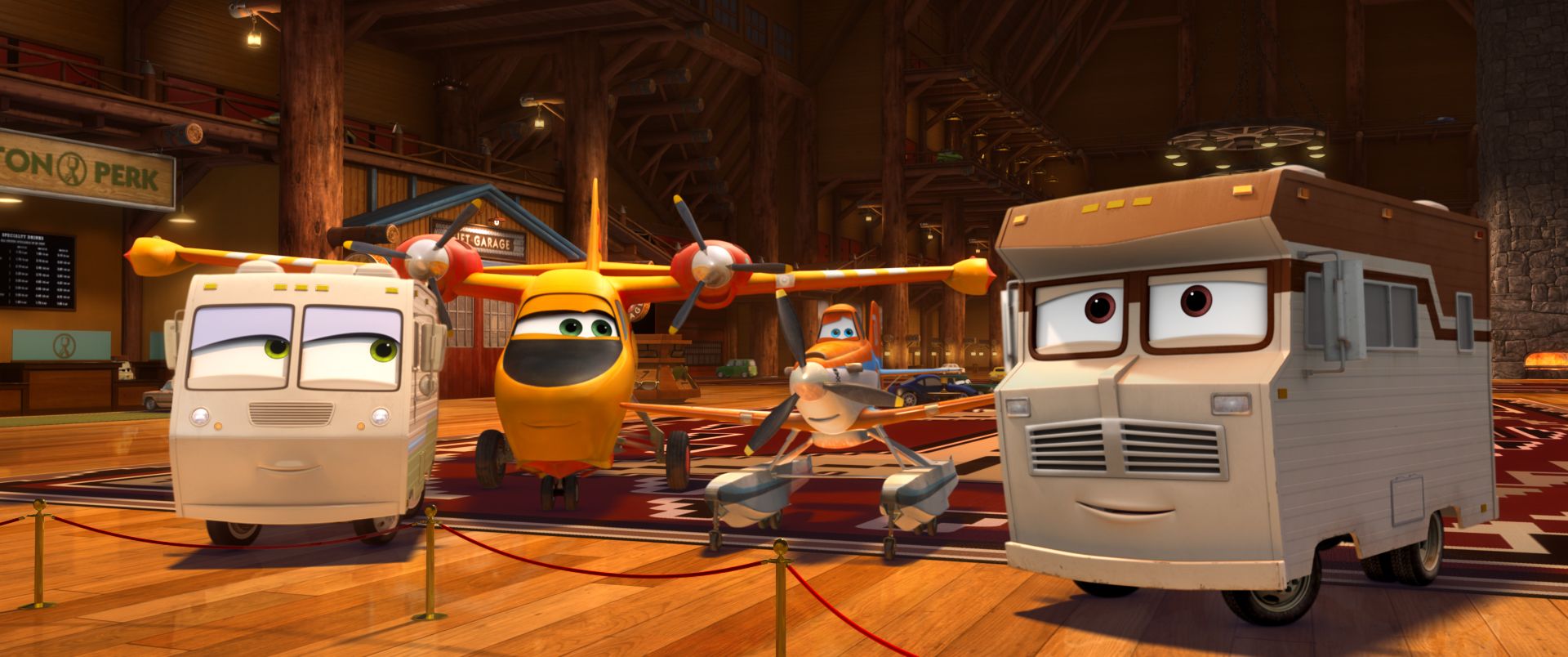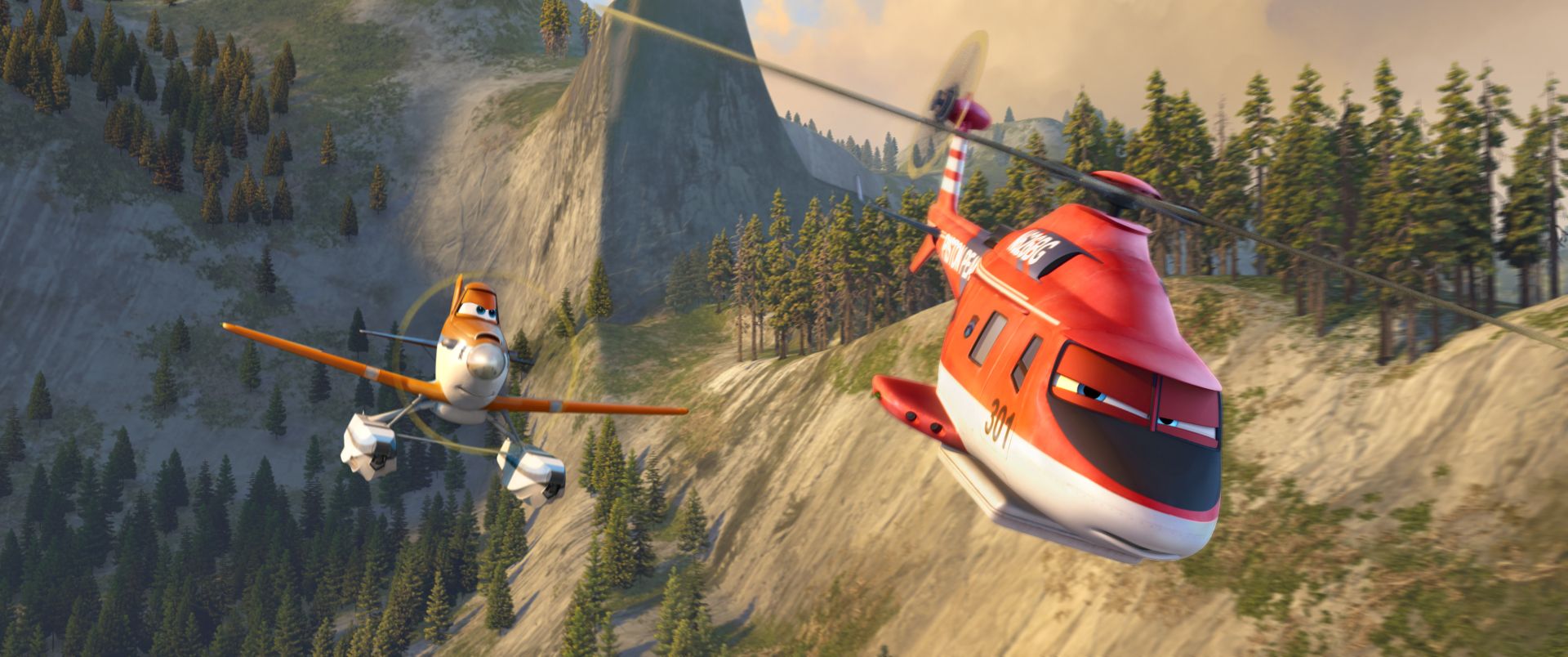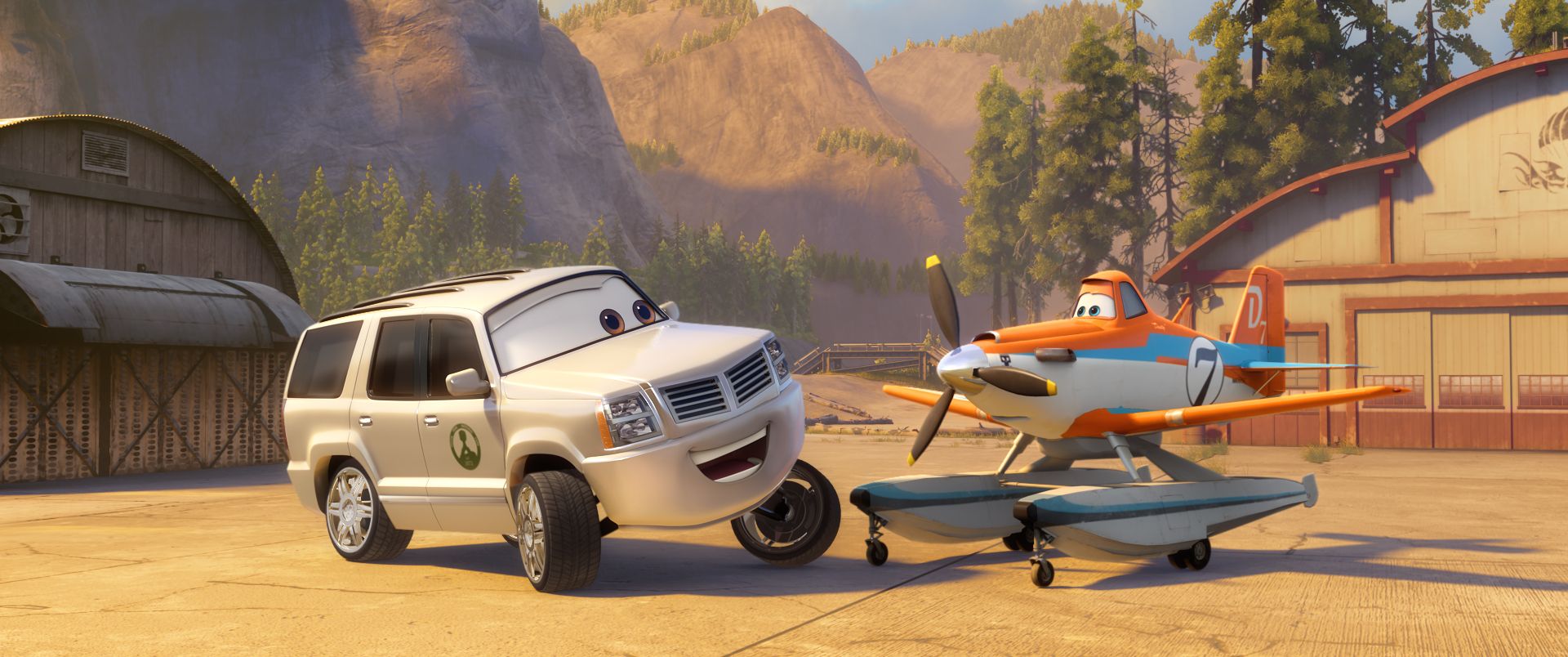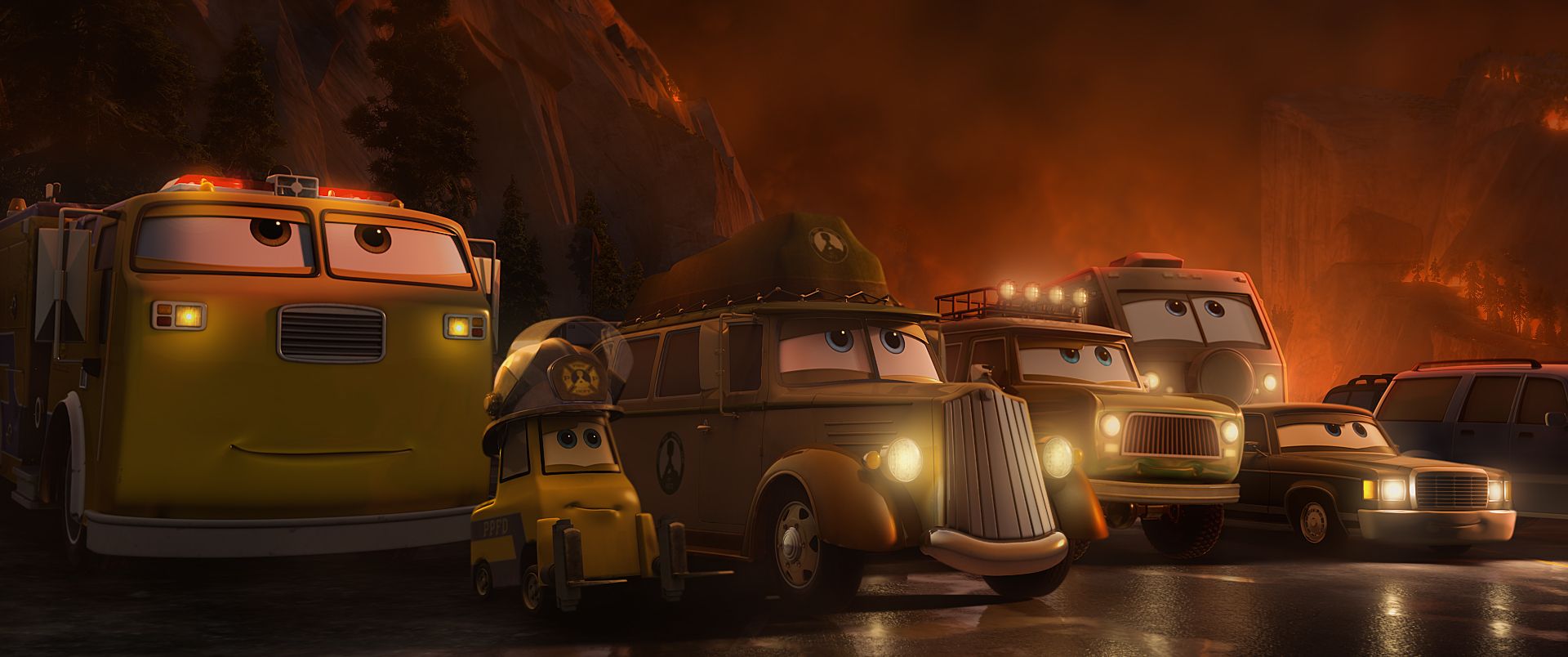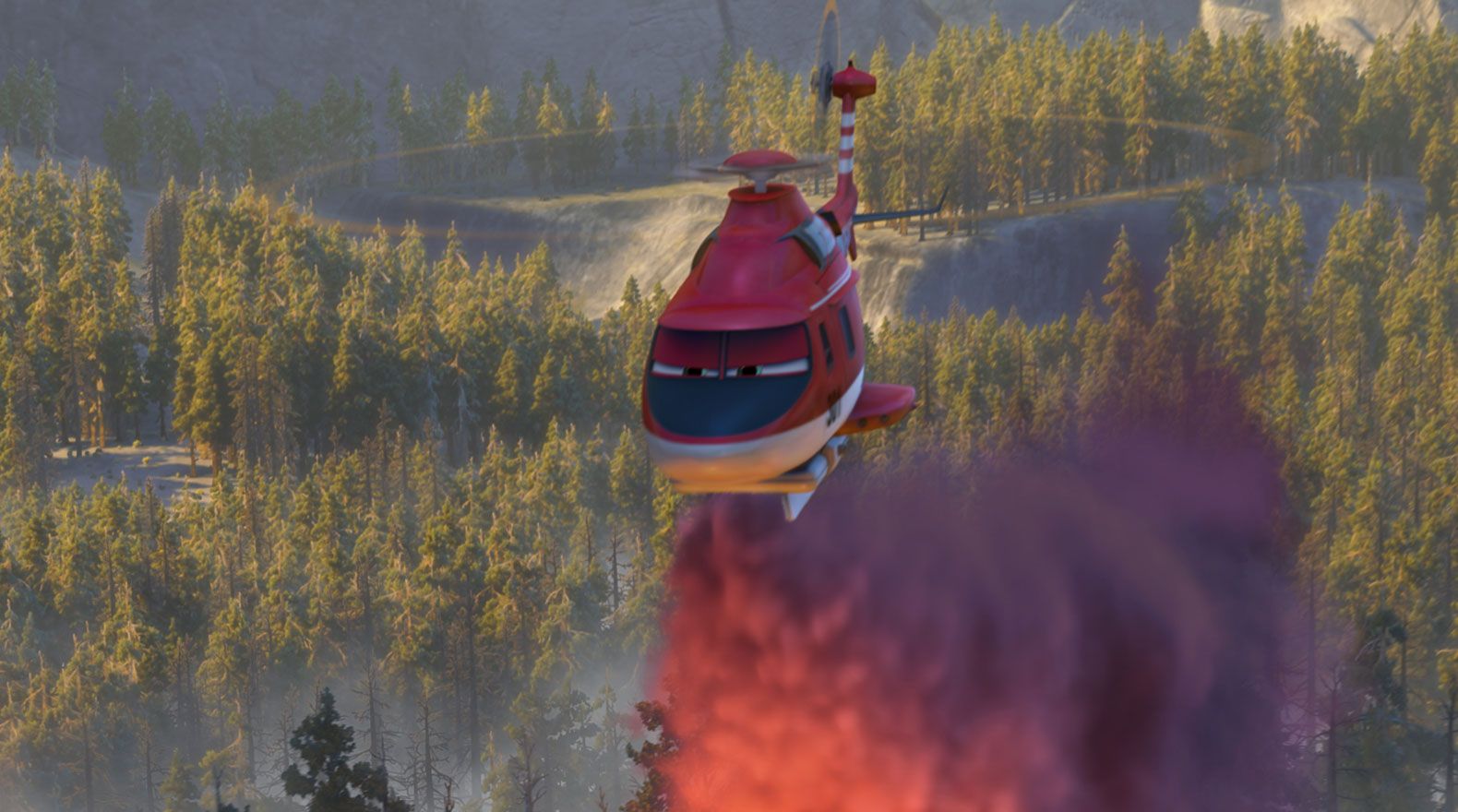Think of director Bobs Gannaway and producer Ferrell Barron as the air-traffic controllers of Disney’s Planes: Fire & Rescue.
Building off the premise and central character of last year’s animated hit Planes – itself an offshoot of Pixar’s hugely popular Cars franchise – the film soars through new story territory by putting its crop-duster-turned-racing plane Dusty into a fresh, dramatic context: working to extinguish forest fires. Along with the compelling new framework, the filmmakers have also added a fleet of new characters accompanying Dusty on his mission and a more dynamic view of the aerial acrobatics that ensue.
Gannaway and Barron sat down with Spinoff Online to discuss the franchise’s mini-reinvention, and expanding the increasingly packed Cars/Planes universe.
Spinoff Online: This is that rare breed of sequel that, in my opinion, turned out superior to the original. Did you feel like something special was happening as this one started to click into gear?
Bobs Gannaway: We talked about that. Your story comes in your research, and I think back now on all the things that sort of came together organically, the firefighters and our relationship with them, the national parks, the theme of second chances. It sort of threads into the air-attack bases and fire. To make that happen, that has to organically happen in the process. We did make some choices specific to make sure that we weren't derivative of the previous film by ending up in a different genre, and making choices just like where Blade Ranger, the battalion chief for the Piston Peak Air, is not a “broken” mentor. He doesn't need to be healed by Dusty. He's fully realized. So I tried to make some choices that I was not going to be repeating story beats – the biggest being, of course, it's not erasable. But I think all that aside, these are conscious choices. It was the coming together organically of things that was when the magic happened, and it all just kind of felt right. And all the different teams were elevating it. The fire fighters, the ranger's national parks, and of course, our story team and the effects artists, everybody felt like they were all going to the same place.
"Planes: Fire & Rescue" Star Julie Bowen Dips Into the Highs and Lows of Celebrity
Along with a whole new backdrop and a new crop of characters, the look of the film is really another quantum leap ahead. You made the decision to shoot it differently than the first.
Gannaway: Yeah, definitely shoot it in CinemaScope. My background, I was at film school in USC. My background is writing, and I'll say sort of traditional filmmaking. So not only shooting CinemaScope, but just the way we're shooting the scenes, keeping it almost sort of live action feeling in the sense of where we place the camera and elements like that that sort of help ground it. Keep the movie feeling like it's a real place and a real set with real characters. That's one of the big things that we do.
I enjoy geeking out about this expanding Cars/Planes universe – there's something cool and fascinating about this world that you guys are creating. From your side of the equation, tell me about building that out.
Gannaway: Well, the frustrating thing is, there are so many great vehicles. And for us, even with our air attack, there are so many different kinds of planes that are used in air attack, and we feature only a few of them. A good example is, the air-attack officer who flies a Bronco, and he usually circles above the fire, sort of like your air-traffic control in the air; the air-attack officer does not get involved in the firefighting. But we had to sort of combine that role with Blade, with our rescue helicopters, so that he could actually get involved in the firefighting too. But it was like, oh, we already lost a really super-cool aircraft because I needed to kind of combine the characters. But there's so many different aircraft and planes and pilots and interesting people and stories that it's really a sort of an almost endless world out there that you can go and explore. And that's just airplanes.
Tell me about John Lasseter's role as the keeper of the Planes and Cars universe.
Ferrell Barron: Well, he's our ambassador. He's our creative leader for all the studios, our Walt Disney Animation Studios – that's one constant that we all have. The other constant is that he's all about making our studios be filmmaker-driven. That's on the director and producer. He really gives you the keys to your movie and lets you run with it. And he's the one person who comes in that we answer to at the end of the day – except for the other directors; every studio has a group of directors that they all work together. Pixar is what you call the brain trust, and we call in Disney Studios, the story trust, so all the directors kind of work with each other. Klay Hall in the first movie was very much involved with Bobs. Bobs helped him on the first one as well as other directors: always getting fresh eyes and ears on it, helping you push through those hard things, always was pushing you to elevate, not get too comfortable in the position you are. Always wanting to push, take risks, elevate the storytelling. And then John, of course, is so great at that because he's a filmmaker at heart. He's not a suit, an exec. He is a director, he's directed. He's an artist. That's what his background is, so having him overseeing this all, being our true champion has helped all the studios and certainly the Disney studios just want to make great movies at the end of the day.
And he has a passion for this particular environment.
Gannaway: Yeah, obviously, Cars is his passion, and so here we are getting sort of to play in his sandbox. But he very much wants you to make your movie because, by having it be a filmmaker in a different studio, by having each filmmaker sort of own their whole story -- I'm sure you're aware of this, but Pixar and Walt Disney Animation Studios, we don't take outside pitches. People can't come in and pitch an idea for a movie, because these aren't assignments. These are passion projects of each director, so by having the story come from the director, there's a sense of ownership. And then John comes in and guides you and helps you. And he's a voice of experience to sort of come in and help you make your movie. If he wants to make a movie, he can just go make a movie. He can do whatever he wants [laughs]. So he doesn't want to make my movie, he wants me to make my movie. And obviously, he's got storytelling chops that are amazing. So he's there every step of the way, right down to when we get the final cut. And when we make the movie, we sit in editorial. We watch the film. We talk about choices – nip and tuck, frame. It's up until the last minute.
Tell me about the influence that the real-life fire and rescue people had on you as you made the movie, anecdotal things you learned directly from working with them and how their personas influenced what you were doing.
Gannaway: Well, my favorite story is when we first went out to meet them. We went out to Hemet-Ryan [Airport, in California], I walked on the air-attack base – again, this invisible thing that I don't really see, like a fire station in town – we see it, the doors open, we hear the sirens. These guys are out on these airstrips way outside of town. All the buildings were, like, on raised foundations, so the foundation was about 3 feet off the ground, the whole porch and Travis came out: Travis is 6 8 – so he was now 9 feet, 8 inches tall and rock solid. So here is a firefighter, and I just all of a sudden became like a Cub Scout looking up at this firefighter and was just so impressed. And it ends up this guy's got a heart of gold – nicest guy in the world! I mean, everything you want a firefighter to be. And it's not necessarily an anecdote as much as when we first went out and met them, we're like, “Wow.” These guys are everything you'd think they'd be.
Barron: And just like a city firehouse, they're just normal guys when they're off the clock. And it's just fun to see, when that alarm goes off, how they kick into gear -- how they can quickly just flip that switch in their heads and focus on the immediate task at hand, be professional, know that there's danger out there, lives are at risk. Whatever that alarm is calling, they don't know until they get out there, but they gear up, prepare and fly out with one purpose and one purpose alone which is to, at the end of the day, they need to save lives and putting themselves at risk in doing so. And that's what always stuck with us. And after having met with them and then becoming friends, as Bobs said, because now we have a personal relationship with some of these guys – knowing what they do for the community every day, I mean, it just really hit home. It made this movie even more important for us to play homage and tribute to these guys, men and women both, around the world. Because this is the profession that any country can relate to is firefighting in some capacity.
Gannaway: [The firefighters] were going to fix a barbecue lunch for our story team so our story team could walk the base and look at the planes, talk to the pilots. And the second they finished lunch or, like, in the middle of lunch, the alarm went off, and everything just dropped. And they went from like the casual guys hanging out and talking to bang! “We've got to get loaded and out as quick as possible.” And that's much like the film and scene in the movie. Dusty actually asks the question, “It's an actual fire?” And Dipper says, “Yeah. It happens every day. You only hear about the big ones.” Well, one of the firefighters who watched the movie said that's his favorite line in the film, because it's true. That they are out fighting fires every day, but you only hear about the big ones. So he just loved that line.
Being in the unique position of making these two films right on top of one another, what were the lessons or things that happened with the first one that had a learning effect for the second one?
Gannaway: Well, the main thing that we were able to do was build on the things that Klay Hall had tackled successfully in the first film, the biggest one being the accuracy of the flight. He put together a fantastic team of artists and consultants to make sure the flight is accurate. And we were able to sort of inherit that team and then we were able to add, in our case, helicopters to that mix. So I think one of the big things that we inherited was the flight.
Barron: That's the one thing that I think of too because it is planes. So it has to be accurate. So they went through a lot of struggle with getting that team, finding the right mix of people that could help them bring reality to that flight. So we were already set up for success because of inheriting that same team. Other than that, our movies are so different. The other thing is, as Bobs said, the reason we change filmmakers is because we don't want to be derivative of the other previous movies. So that's why it was so important for us to go in a different path than the first movie. Tell a different story, put Dusty in different situations that's going to be unique and make our movie specialize in some sense.
Gannaway: Yeah. One of the things, that first film was a race film, and that may have felt a little familiar to the audience. So we were able to sort of look at that, and we ended up exploring this new world. But it's a world that would really happen because Dusty, in real life, is in the same, in air attack. So it's not like we just randomly spun the wheel and said, “We've got to change something. I don't know, let's do firefight. That sounds cool.” It all came from research. Research informs everything. We don't even start writing the story until we've done months and months of research because all those things come back and inform the story. Like I said, right down to – the reason why we have Boat Reynolds in the movie is because I saw a sign at Yellowstone that said “Boat Rentals.” And I said quickly, “Oh, we're in Yellowstone. ‘Boat Rentals” … Boat Reynolds. Write that down.” So research. Getting out of your office can inform everything from the biggest story point to the smallest story point. The other one that's interesting is when Blade takes Dusty into the mine to protect him in the burnover sequence. That's based on a true historical event where Pulaski, a very famous firefighter story from 1910 in Ohio, I think it's Ed Pulaski, saved his team of rookie firefighters from a fire by taking them to a mine and letting the fire burn over. And he stood at the door to make sure none of them ran out. So that scene's based on a true historic event. The general audience doesn't know that, but I've had many firefighters come up and go, “That's the Pulaski story.” I go, “Yes, it is.”
I understand the story comes first and then other factions Disney can do the licensing and marketing -- but I kept seeing this as a “-land” at Disneyland or California Adventure. The environment that created on screen was so cool and immersive. Do you fantasize about things like that?
Gannaway: Well, here's the thing: the thing that's important for everyone to know is a lot of people think, “Oh, great – this is just something to sell toys and stuff like that.” The thing is, none of the ancillary divisions of the company or the other divisions of the company inform our content. We're just all about telling a great story and making appealing characters, making it a believable and real world. And if we've done our job right, then other divisions of the company can sort of come in and sort of do what they want to do with the characters we've created. That being said, we're all Disney fans. Everybody at work, all the directors, and the idea of creating something that we think would be cool and fun to make a fun experience at the park or a fun toy, we don't really have to work that muscle very hard because that comes sort of preloaded in being a Disney fan.
Do you have a desire to stay working in this world of living vehicles – cars, planes, maybe a new community?
Barron: This world is intriguing because there's such a wide range of vehicles from all over the world that you could tap into that all have interesting stories and a ride that you could dive into. Personally, I really love this world, and I'm interested in continuing to look into it. But Disneytoons were series-based, so we made this great world to do that very thing: support multiple movies in the world. But we're not under a time clock where we have to like, “Quick – we've got another one to do in one year.” It's all about doing research and finding the story from that research as we did with this one that's unique and interesting and inspiring enough for us to want to invest the amount of time that it takes – four years of process before we do that. I'm hoping to, but we'll see where it leads us.
Gannaway: And also, I love it! That's why I got into animation is bringing things to life that aren't normally alive, so I love working this world. But the cool thing about it is, there are so many cool vehicles out there, but what's even cooler are the people that fly them or drive them or the stories that they have. So you go out, and you find these awesome vehicles and then you meet the fantastic people that pilot these planes or drive these cars. And you get to sort of tell their story in kind of an interesting, different angle. It's a fun, rich world. I love working in it. Happy to be here.
Disney’s Planes: Fire & Rescue opens today nationwide.

